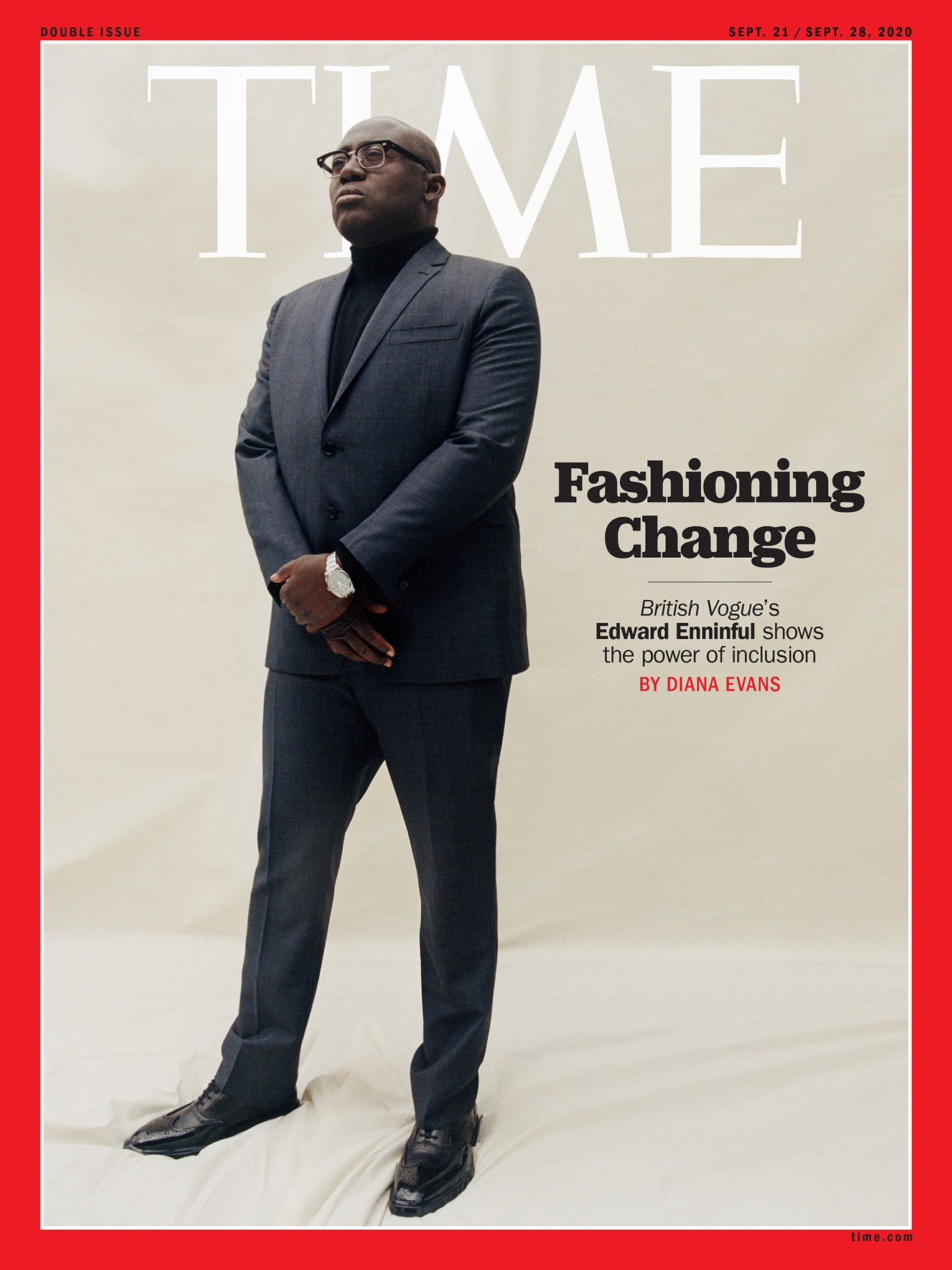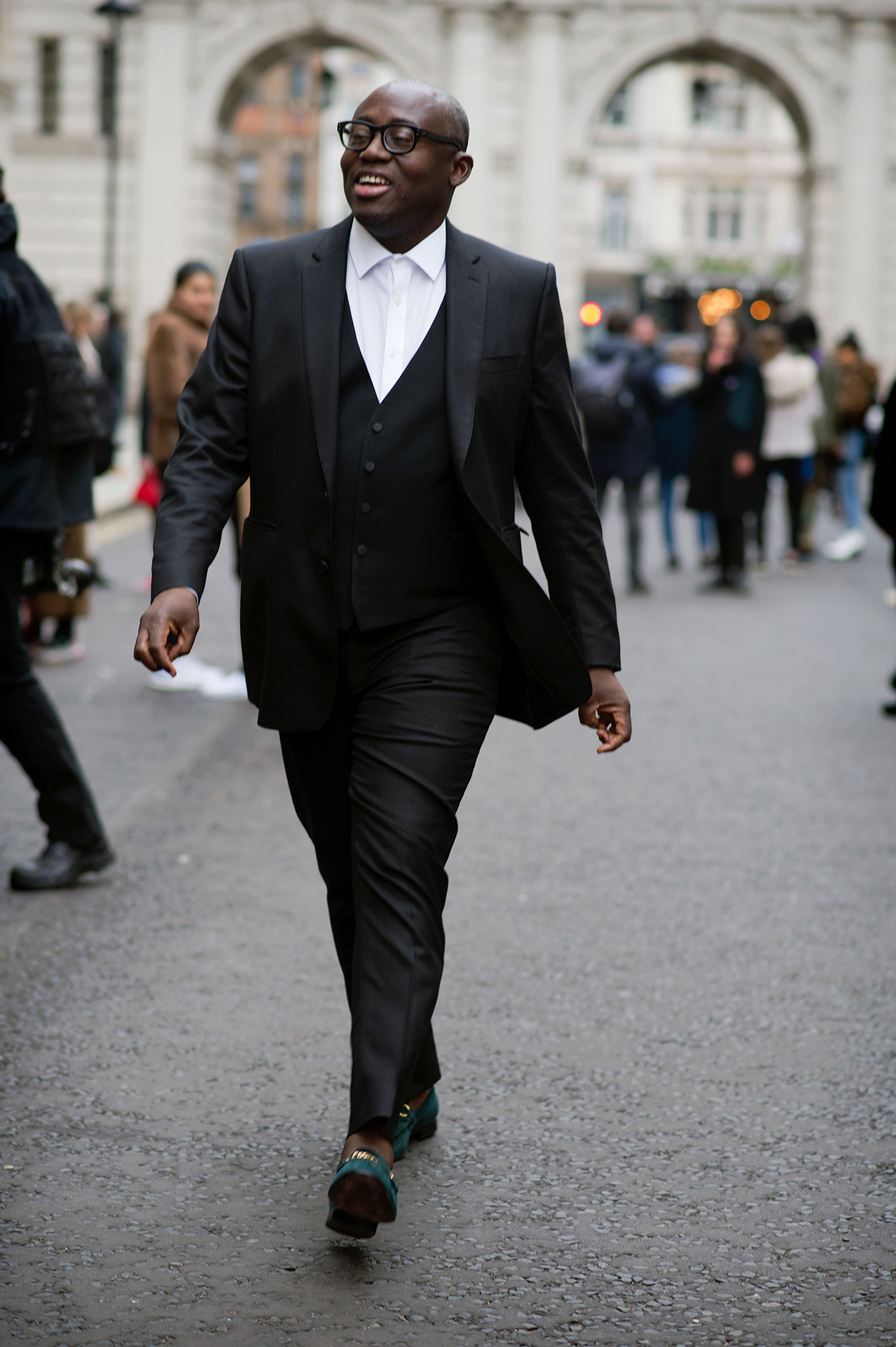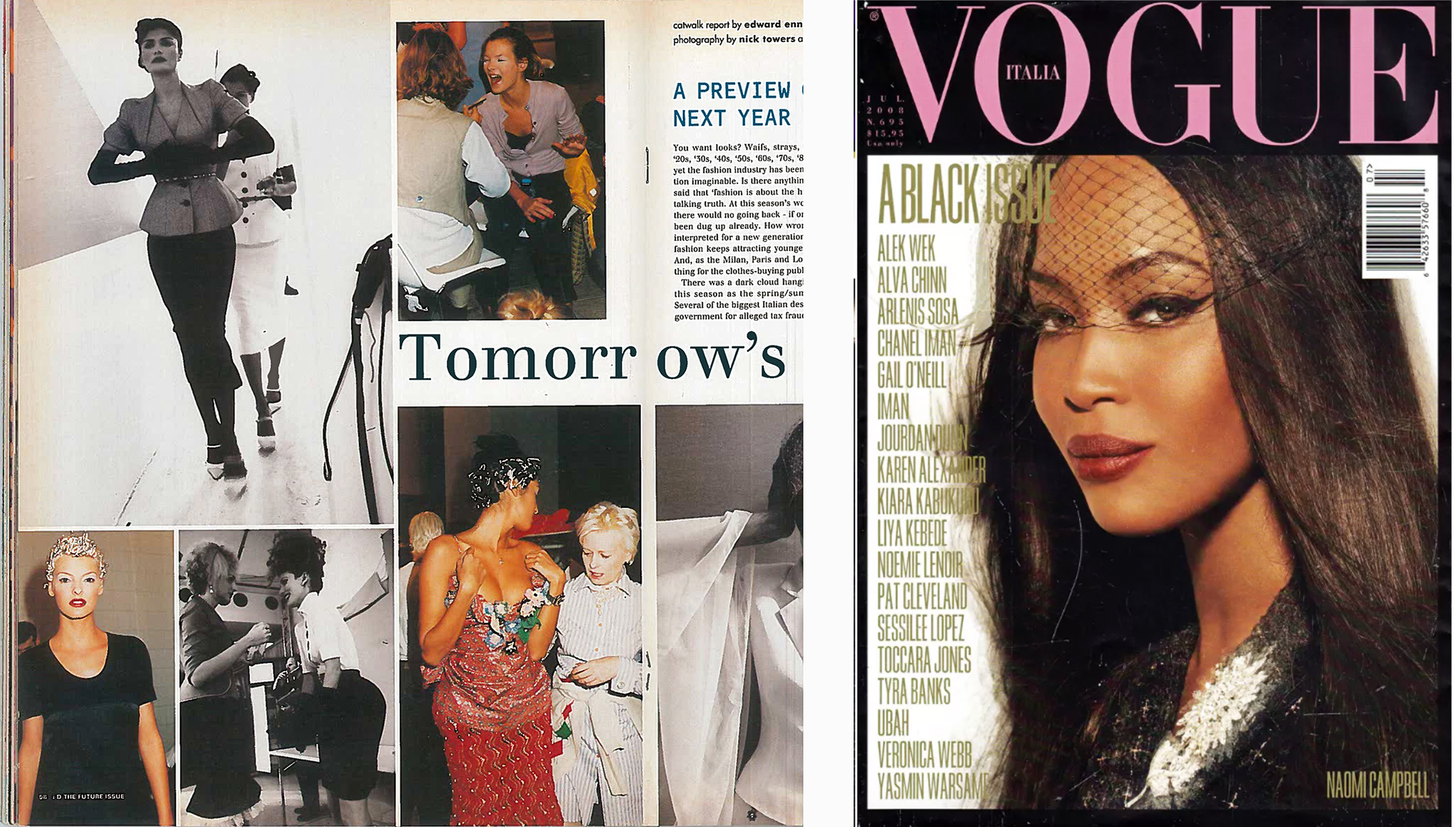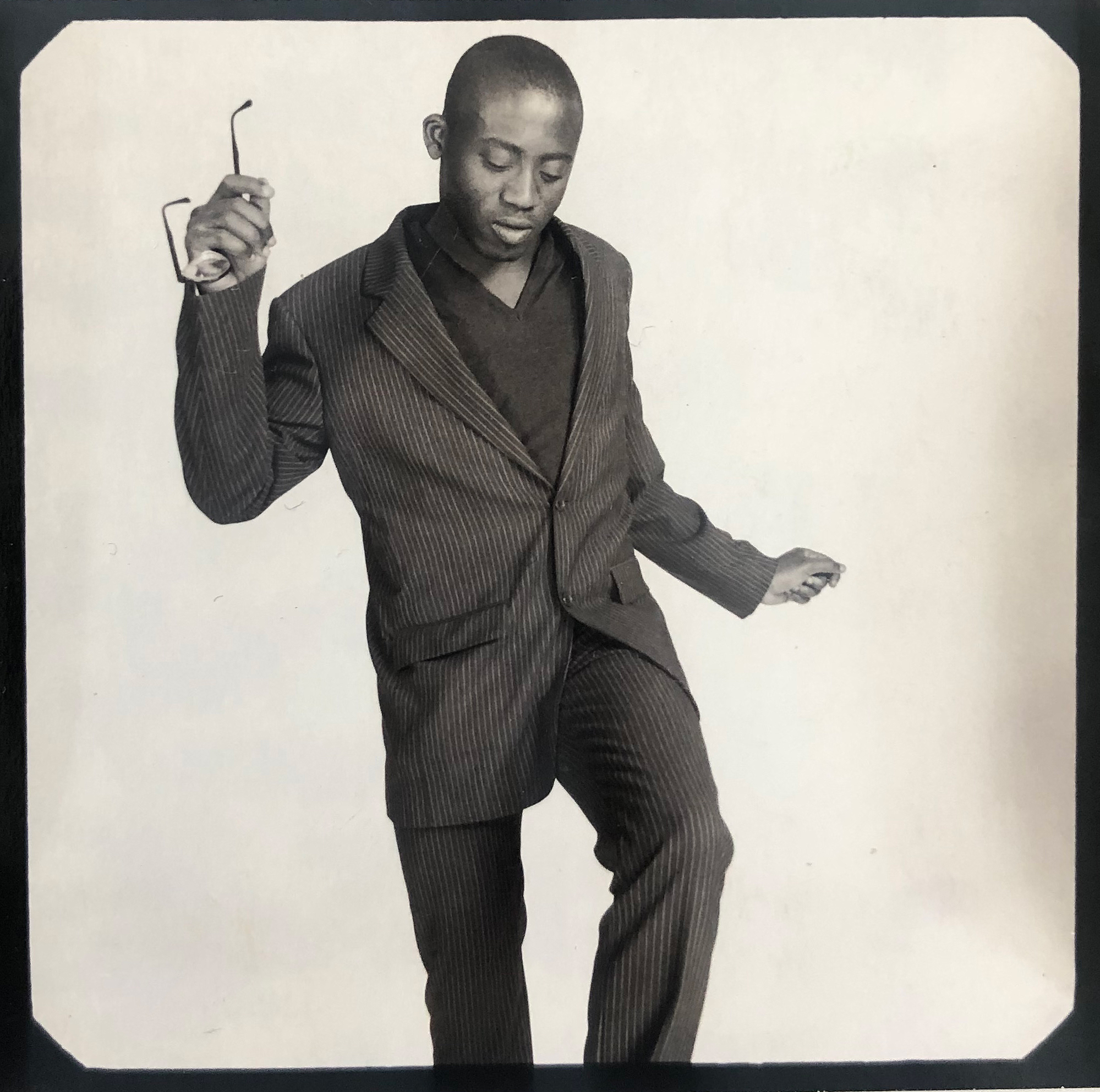
August 2020 saw no soca floats sliding along West London’s Ladbroke Grove. No pink feathered wings or giant plumes of headwear. The Notting Hill Carnival was canceled, like all mass gatherings in late COVID lockdown, the streets still spare, the air still choked with grief. No curry goat or jerk pan smoke rose up into the city trees. And the music, the great churning music of the Caribbean islands, of Black Britain, of Africa and the Americas, did not thump to the foundations of the neighborhood terraces, making them tremble.
All of this would have been part of a normal summer for Edward Enninful while growing up in the area in the 1980s. His mother Grace might look out of the window of her sewing room in their house right on the Carnival route, and see some manifestation of Trinidad going by, or a reggae crew, wrapped in amazing sculptures of bikini and shiny hosiery. Edward, one of six siblings, would stay out late and take it in, all that sound and spectacle, which for decades has been the triumphant annual pinnacle of London’s cultural and racial multiplicity.
It was this world that nurtured his creativity and helped shape the vision he has brought to the pages of British Vogue since being appointed editor in chief in 2017. “I was always othered,” Enninful says on a nostalgic walk through the streets of Ladbroke Grove, a much gentrified, still bohemian part of London, where he moved with his family from Ghana at the age of 13, “you know, gay, working-class, Black. So for me it was very important with Vogue to normalize the marginalized, because if you don’t see it, you don’t think it’s normal.”
Today, Enninful is the most powerful Black man in his industry, sitting at the intersection of fashion and media, two fields that are undergoing long-overdue change and scrambling to make up for years of negligence and malpractice. Since becoming the only Black editor in history to head any of the 26 Vogue magazines—the most influential publications in the multibillion-dollar global fashion trade—he has been tipped as the successor to Anna Wintour, the iconic editor of American Vogue and artistic director for Condé Nast. The privately held company is navigating, on top of an advertising market battered by the COVID-19 pandemic, public controversies around representation both in its offices and on its pages.

Enninful’s vision for British Vogue comes at a critical moment for the international publisher. “I wanted to reflect what I saw here growing up, to show the world as this incredibly rich, cultured place. I wanted every woman to be able to find themselves in the magazine.” He chose the British model Adwoa Aboah to front his first issue, in 2017: “When others took steps, Edward took massive strides, showing the importance of our visibility and stories,” she says. Covers since have featured the likes of Oprah Winfrey, Rihanna, Judi Dench (at 85, British Vogue’s oldest cover star), Madonna and soccer player Marcus Rashford, photographed for this year’s September issue by Misan Harriman, the first Black male photographer to shoot a British Vogue cover in its 104-year history. While other publications, including American Vogue, have reduced frequency during the pandemic, British Vogue has remained financially stable and is still producing 12 thick issues in 2020.
Under Enninful, British Vogue has morphed from a white-run glossy of the bourgeois oblivious into a diverse and inclusive on-point fashion platform, shaking up the imagery, tracking the contemporary pain. Its shelf presence is different—more substance, more political—and perhaps in part because of it, the shelf as a whole looks different. No more do Black women search mainstream newsstands in vain for visions of themselves. Now we are ubiquitous in my newsagent, in my corner shop, and it really wasn’t that hard; all it took was to give a Black man some power, to give someone with a gift, a voice and a view from the margin a seat at the table.
“My Blackness has never been a hindrance to me,” Enninful says. Yet he is no stranger to the passing abuses of systemic racism. On a Wednesday in mid-July, while entering British Vogue’s London headquarters, he was racially profiled by a security guard who told him to enter via the loading bay instead. “Just because our timelines and weekends are returning to normal, we cannot let the world return to how it was,” he wrote on Twitter. This summer, in the wake of worldwide Black Lives Matter protests sparked by the killing of George Floyd, we are seeing a seismic reckoning across industries, scrutinizing who is doing what and who is not doing enough to bring about real change in equality and representation. “My problem is that there’s a lot of virtue-signaling going on,” he says. “But everyone’s listening now, and we need to take advantage of that. This is not the time for tiptoeing.”
We meet at Ladbroke Grove tube station in a late-summer noon. When anticipating an interview with the leader of a historic luxury fashion bible, it’s tempting to have inferior thoughts about your Nissan or your Clarks boot collection or your latest unlatest something, but Enninful, 48, is unassuming, arriving in a loose navy suit, pale blue shirt and shades, the only giveaway to his sartorial imperium the no socks with his brogues. He is warm and relaxed, bearing the close-shouldered tilt of the lifelong hard worker; he rises at 5 a.m. most days to meditate before work.

These days he resides toward Lancaster Gate, on the posher side of Ladbroke Grove, with his long-term partner the filmmaker Alec Maxwell and their Boston terrier, Ru Enninful, who has his own Instagram account and whose daily walking was a saving grace during lockdown. But the London Underground is where Enninful’s journey into fashion began, one day on the train in a pair of ripped blue jeans, when he was spotted by stylist Simon Foxton as a potential model for i-D, the avant-garde British fashion magazine. Being only 16, a shy, sheltered kid who grew up in a Ghanaian army barracks and who was less than four years in the U.K., of course he had to ask his mother. Albeit a clothes fanatic herself, a professional seamstress and regular rifler (with Edward) through the markets of Portobello and Brixton for fabrics, Grace was wary of the hedonistic London style vortex, the enormity of the new land, and reluctant to release her son into its mouth. He begged. He wore her down: “I knew I couldn’t just walk away from this, that something special was going to come out of it.”
He never had the knack for modeling, he says with characteristic humility. “I was terrible at it. I hated the castings, all that objectifying. But I loved the process and the craft of creating an image.” He soon moved to the other side of the lens, assisting on shoots and assembling image concepts and narratives, a particular approach to styling that impressed i-D enough to hire him as their youngest ever fashion director at only 18, a post he held for the next 20 years. Without the courtesy designer clothes later at his fingertips, he would customize, shred, dye and bargain for the right look, using the skills he’d developed at home in the sewing room. “I realized that I could say a lot with fashion,” he says, “that it wasn’t just about clothes, but could tell a story of the times we’re in, about people’s experiences in life. And that freedom to portray the world as you saw it.”
What was innate to Enninful—this blend of skilled creativity with the perception of difference as normal, as both subject and audience—was relatively unique in an industry dominated by white, colonial notions of beauty and mainstream. Legendary Somali supermodel Iman remembers a 2014 W magazine shoot in which she, Naomi Campbell and Rihanna were cast by Enninful, the publication’s then style director, wearing Balmain, designed by Olivier Rousteing. “Until Edward appeared, no one at the mainstream fashion magazines would have cared to commission a portrait exclusively featuring three women of color, and furthermore who were all wearing clothes designed by a person of color,” she says. “He’s an editor in vocation and a reformer at heart, compelled to spur woefully needed social change.”

He shows me his various old haunts and abodes, the top-floor bedsit where he used to haul bags of styling gear up the stairs, the Lisboa and O’Porto cafés of Golborne Road—or “Little Morocco”—where he’d sit for hours chewing the fat with people like makeup artist Pat McGrath, Kate Moss, Nick Kamen and photographer David Sims. Name-drops fall from his lips like insignificant diamonds—stylists, photographers, celebrities—but he navigates his domain in a manner apparently uncommon among fashion’s gatekeepers. Winfrey says of him, “I have never experienced in all my dealings with people in that world anyone who was more kind and generous of spirit. I mean, it just doesn’t happen.”
Her shoot for the August 2018 cover of British Vogue left Winfrey feeling “empress-like,” and she ascribes his understanding of Black female beauty to his being raised by a Black mother. “Edward understands that images are political, that they say who and what matters,” she adds. Enninful’s father Crosby, a major in the Ghanaian army who was part of U.N. operations in Egypt and Lebanon, had thought that his bright, studious son would eventually grow out of his fascination with clothes and become a lawyer. But three months into an English literature degree at Goldsmiths, University of London, studying Hardy, Austen and the usual classics, thinking maybe he’d be a writer, or indeed a lawyer, Enninful quit to take up the position at i-D. His father did not speak to him for around 15 years, into the next century, until Grace suffered a stroke and entered a long illness. “Now that I’m older, I realize he just wanted to protect us. He’s come to understand that I had to follow my heart and forge my own path.”
He credits his parents for his strong work ethic—“drummed into you from a very early age by Black parents, that you have to work twice as hard”—and his Ghanaian heritage for his eye for color. His approach to fashion as narrative comes from the “childish games I would play with my mother,” creating characters around the clothes, sketching them out. “I can’t just shoot clothes off the runway,” he says. “There always has to be a character, and that character has to have an inner life.” Since Grace’s death three years ago, his father has lived alone by the Grand Union Canal and is very proud of his son, particularly of the Order of the British Empire awarded to him by Queen Elizabeth II in 2016 for his services to diversity in fashion. The Queen, incidentally, is high on Enninful’s list of Vogue cover dreams.
The British Vogue Enninful inherited from former editor in chief Alexandra Shulman three years ago was starkly different from today’s rendition. During her 25 years in charge, only 12 covers out of 306 featured Black women, and she left behind an almost entirely white workforce. Now the editorial team is 25% people of color—“I needed certain lieutenants in place,” he says—and similar shufflings are being called for over at Condé Nast in New York. Enninful is reluctant to tarnish names any further, maintaining that Shulman “represented her time, I represent mine,” and declining to comment on the U.S. headquarters.

Enninful’s rise is particularly meaningful to people like André Leon Talley, former editor at large of American Vogue, where Enninful also worked as a contributing editor. Talley describes the new British Vogue as “extraordinary,” and was joyous at Enninful’s appointment. “He speaks for the unsung heroes, particularly those outside the privileged white world that Vogue originally stood for. He has changed what a fashion magazine should be.”
“I’m a custodian,” Enninful says of his role, sitting in a sumptuous alcove of the club bar at Electric House. “Vogue existed before I came, and it will still exist when I leave, but I knew that I had to go in there and do what I really believed in. It’s our responsibility as storytellers or image makers to try to disrupt the status quo.” Ironically, though, he does not see himself as an activist, rather as someone who is unafraid to tackle political issues and educate others, while remaining firmly within the Vogue lens. “They said Black girls on the cover don’t sell,” he says. “People thought diversity equals down-market, but we’ve shown that it’s just good for business.” British Vogue’s digital traffic is up 51% since Enninful took over. He previously edited the 2008 Black issue of Vogue Italia, which featured only Black models and Black women and sold out in the U.S. and the U.K. in just 72 hours.
Since the incident with the security guard in July—which Enninful reveals was not isolated and had happened before (the culprit, a third-party employee, was dismissed from headquarters)—building staff have been added to the company’s diversity-and-inclusion trainings. Enninful would also like to see financial aid put in place for middle management, “because we forget sometimes that the culture of a place does not allow you to go from being a student to the top.” In 2013, he tweeted about another incident, where he was seated in the second row at a Paris couture show while his white counterparts were placed in front. “I get racially profiled all the time,” he says, going right back to his first experience of being stopped and searched as a teenager, which “petrified” him. “When I was younger, I would’ve been hurt and withdrawn, but now I will let you know that this is not O.K. People tend to think that if you’re successful it eliminates you, but it can happen any day. The difference now is that I have the platform to speak about it and point it out. The only way we can smash systemic racism is by doing it together.”

Activism, then, is intrinsic. Fashion is altruism, as much as story and craft, as much as the will to capture beauty. For Enninful, there is no limitation to the radicalism possible through his line of work. Rather than the seemingly unattainable elements of style (the £350 zirconia ring, the £2,275 coat) obscuring the moral fiber of the message, the invitation to think and see more openly, the style instead leads you to it, perhaps even inviting you to assemble something similar within the boundaries of your real, more brutal, less elevated existence. “Relatable luxury,” he calls it, and though it’s difficult to imagine exactly how one might evoke a £2,275 coat without his customizing skills and magical thinking, I am inclined to accept the notion, partly because I saw soul singer Celeste in a £1,450 dress in the September issue and think I might give it a try. Anything is possible. “I still feel like I’m at the beginning,” he says with palpable optimism. “I feel the fire of something new.”
—With reporting by Cady Lang/New York and Madeline Roache/London
Evans is the author of Ordinary People, The Wonder and 26a
Cover photo: Styling: Susan Bender; Suit, sweater, shoes: Burberry
More Must-Reads from TIME
- Caitlin Clark Is TIME's 2024 Athlete of the Year
- Where Trump 2.0 Will Differ From 1.0
- Is Intermittent Fasting Good or Bad for You?
- The 100 Must-Read Books of 2024
- Column: If Optimism Feels Ridiculous Now, Try Hope
- The Future of Climate Action Is Trade Policy
- FX’s Say Nothing Is the Must-Watch Political Thriller of 2024
- Merle Bombardieri Is Helping People Make the Baby Decision
Contact us at letters@time.com